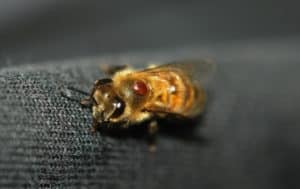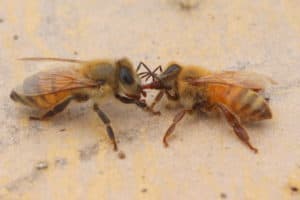I came to the world of bees by accident and had no bee-specific knowledge or training prior to becoming a beekeeper. Prior to working with Bee Informed Partnership (BIP), I spent 8 years as a commercial beekeeper where I gained a good understanding of bee behavior and management from practical experience. Since joining BIP, the exposure to colleagues and scientists has led to a lot of “lightbulb” moments where an unfamiliar word was used and I had to ask what it meant. The explanation was normally met by an, “Oh sure, I’ve seen that, I just didn’t know there was a word for it,” or similar reaction. Below are a few of the interesting terms I’ve picked up in recent years.

Corbicula: Commonly called a pollen baskets, the corbicula is the flattened surface on the lower hind legs. This specialized anatomy allows honey bees to store pollen during foraging in order to be transported back to the colony.
Diutinus: The technical name for winter bees that are capable of surviving the lengthy period of dormancy in winter climates until new brood-rearing commences in the spring by storing food reserves in their fat bodies.
Eclosion: Although commonly referred to as hatching or emerging, the act where a developed bee chews open its pupal case and exits the cell.
Festooning: The behavior in which young bees cling to each other, creating a lattice or chain. It is not definitively known why bees behave this way, but festooning is most common when fresh wax is being drawn.
Haplodiploidy: A genetic description of honey bees and other hymenopterans (bees, ants, wasps) where females develop from fertilized eggs and males develop from unfertilized eggs. Haplodiploidy results in females having twice the number of chromosomes as males and unconventional family trees where males are have neither fathers nor sons but do have grandfathers and grandsons.
Nasanoving: A behavior where bees extend their abdomen to expose the nasonov gland and emit a pheromone that aids in orienting and recruiting nestmates. Commercially available swarm lures contain synthetic nasanov pheromone to attract swarms.

Phoretic: A relationship where one species clings to another and is transported further than it is capable of moving on its own. In the context of honey bees, varroa mites are said to be phoretic when they are attached to adult bees as opposed to reproducing in cells. Common varroa monitoring techniques like the alcohol wash, sugar shake, and ether roll monitor the level of phoretic mites, commonly expressed as a percentage of mites per 100 bees.
Retinue: The small group of bees that move through the colony with the queen. Members of the retinue perform tasks for the queen including feeding, grooming, waste removal and pheromone dispersal.
Temporal Polyethism: Worker bees progression of tasks and roles throughout their lifespan which is generally understood to transition from ‘indoor jobs’ including nursing and comb construction to ‘outdoor jobs’ that include guarding and foraging.
Thixotropic: A physical property of some substances where mechanical agitation results in a change from a solid/gel state to a liquid. Manuka and some other varietal honeys are thixotropic and require an extra machine to agitate the honey after it is uncapped so it will flow freely from the comb.

Trophallaxis: Behavior in many social insects where food and pheromones are exchanged through direct contact. When two bees are touching tongues (proboscis), they may be communicating information regarding the status of the queen or a newly discovered food source. Unfortunately this type of contact has also been shown to be the manner in which several honey bee maladies are spread within a colony.
Vitellogenin: A protein that determines behavior and foraging preferences as well as influencing the lifespan of individual bees. Elevated vitellogenin levels are critical in diutinus bees having adequate protein to survive winter dormancy.